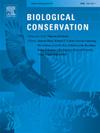A 25-year longitudinal assessment of Macaca sylvanus population dynamics and forest decline in Morocco's Middle Atlas
IF 4.4
1区 环境科学与生态学
Q1 BIODIVERSITY CONSERVATION
引用次数: 0
Abstract
Primate populations are undergoing rapid declines globally. Long-term data are critical for understanding population dynamics and guiding conservation, yet are rare for many threatened species. We conducted a 25-year longitudinal study (1993–2017) to quantify population trends and the effectiveness of conservation measures of the endangered Barbary macaque (Macaca sylvanus) in the Middle Atlas of Morocco, its largest remaining habitat. The study observed a decline from 25 individuals/km2 in 1994 to 5–7 individuals/km2 by 2002, driven by habitat degradation, juvenile trafficking, and competition with livestock. From 2005 onwards, conservation measures, including the establishment of Ifrane National Park, anti-poaching campaigns, and reduced grazing pressure, supported a partial recovery, with densities reaching 21 individuals/km2 by 2017. Key factors contributing to this recovery include enhanced juvenile survival, by reduced poaching, and immigration of adult and subadult males from degraded regions. Despite these apparently positive trends, the population shows a pronounced male bias and static female numbers, suggesting persistent ecological challenges. This demographic imbalance reflects the Middle Atlas cedar forest's role as a refuge but also highlights its vulnerability as surrounding habitats degrade. The findings underscore M. sylvanus as a biological indicator of forest ecosystem health and reveal that the current recovery is contingent on continued conservation efforts. To ensure long-term sustainability, conservation strategies must prioritize female survival, reproductive success, and broader habitat restoration.
These insights reinforce the importance of long-term monitoring in uncovering the deep interconnections between ecological integrity, human activity, and conservation policy that shape outcomes for endangered species.
摩洛哥中部阿特拉斯地区马卡卡森林种群动态和森林衰退的25年纵向评估
灵长类动物的数量正在全球范围内迅速下降。长期数据对于了解种群动态和指导保护至关重要,但对于许多濒危物种来说却很罕见。我们进行了一项为期25年的纵向研究(1993-2017),以量化摩洛哥中部阿特拉斯地区濒危巴巴里猕猴(Macaca sylvanus)的种群趋势和保护措施的有效性,这是其最大的栖息地。研究发现,由于栖息地退化、贩卖幼鱼和与牲畜的竞争,白暨豚从1994年的25只/平方公里下降到2002年的5-7只/平方公里。从2005年开始,保护措施,包括建立伊夫兰国家公园,反偷猎运动和减少放牧压力,支持了部分恢复,到2017年密度达到21只/平方公里。促成这种恢复的关键因素包括:通过减少偷猎,提高了幼鱼的存活率,以及来自退化地区的成年和亚成年雄鱼的迁徙。尽管有这些明显的积极趋势,但种群数量显示出明显的男性偏见和静止的女性数量,这表明持续的生态挑战。这种人口失衡反映了中阿特拉斯雪松林作为避难所的作用,但也突出了它在周围栖息地退化时的脆弱性。这些研究结果强调了森林木是森林生态系统健康的生物指标,并揭示了当前的恢复取决于持续的保护努力。为了确保长期的可持续性,保护策略必须优先考虑雌性的生存、繁殖成功和更广泛的栖息地恢复。这些见解强化了长期监测在揭示生态完整性、人类活动和影响濒危物种结果的保护政策之间的深层联系方面的重要性。
本文章由计算机程序翻译,如有差异,请以英文原文为准。
求助全文
约1分钟内获得全文
求助全文
来源期刊

Biological Conservation
环境科学-环境科学
CiteScore
10.20
自引率
3.40%
发文量
295
审稿时长
61 days
期刊介绍:
Biological Conservation is an international leading journal in the discipline of conservation biology. The journal publishes articles spanning a diverse range of fields that contribute to the biological, sociological, and economic dimensions of conservation and natural resource management. The primary aim of Biological Conservation is the publication of high-quality papers that advance the science and practice of conservation, or which demonstrate the application of conservation principles for natural resource management and policy. Therefore it will be of interest to a broad international readership.
 求助内容:
求助内容: 应助结果提醒方式:
应助结果提醒方式:


